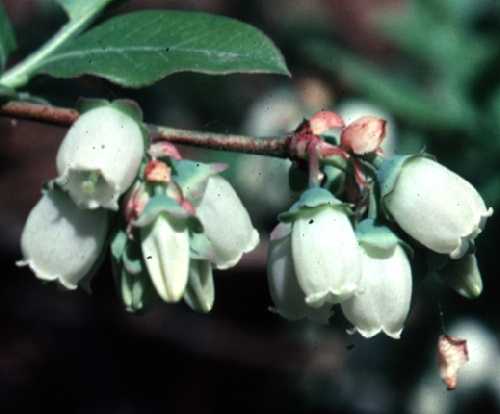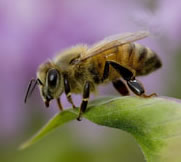Reproduction
The seeds are dispersed by the vast number of birds and animals that eat them. Many animals eat these sweet berries including deer, bears, foxes, skunks, squirrels, mice, and many birds. The seeds are excreted through the animals' waste and deposited in a new location. If conditions are right, the seed will start a new lowbush blueberry plant.
 Cross
pollination is essential for successful reproduction of V. angustifolium.
The main insect that pollinates these flowers is the
honey bee.
The site of reproduction is deep inside the white flower petals. The flowers
grow downward towards the base of the plant. They are only open at one end
and their deep shape attracts the insects deep into the flower. The
sweet nectar is located at the base of the flower. The pollen is also
located inside the flower. The pollen is heavy and sticky and can only
be transferred by an insect, not by the wind. The pollen sticks to the
Cross
pollination is essential for successful reproduction of V. angustifolium.
The main insect that pollinates these flowers is the
honey bee.
The site of reproduction is deep inside the white flower petals. The flowers
grow downward towards the base of the plant. They are only open at one end
and their deep shape attracts the insects deep into the flower. The
sweet nectar is located at the base of the flower. The pollen is also
located inside the flower. The pollen is heavy and sticky and can only
be transferred by an insect, not by the wind. The pollen sticks to the bee and is then transferred to another lowbush blueberry plant. The
stamen is the male reproductive organ of the flower. The female organ
is called the style. The stamen is
shorter than the style which
prevents self fertilization. Cross fertilization is necessary for
successful reproduction among lowbush blueberry plants because it provides
genetic diversity.
bee and is then transferred to another lowbush blueberry plant. The
stamen is the male reproductive organ of the flower. The female organ
is called the style. The stamen is
shorter than the style which
prevents self fertilization. Cross fertilization is necessary for
successful reproduction among lowbush blueberry plants because it provides
genetic diversity.
Life History
The lowbush blueberry has an alternation of generations life cycle. This means that it contains a multicellular haploid phase as well as a multicellular diploid phase. This haploid phase is called the gametophyte. The gametophyte is greatly reduced in flowering plants like the lowbush blueberry. The dominant generation is the sporophyte or diploid phase. The gametophyte undergoes mitosis and produces gametes within an antheridium or produces eggs within an archegonium. The haploid gametes undergo fertilization and develop into the diploid sporophyte. This sporophyte then undergoes mitosis, developing into a mature sporophyte. Spores are produced from the sporophyte after it undergoes meiosis.
Let's learn about the different interactions with other organisms.
